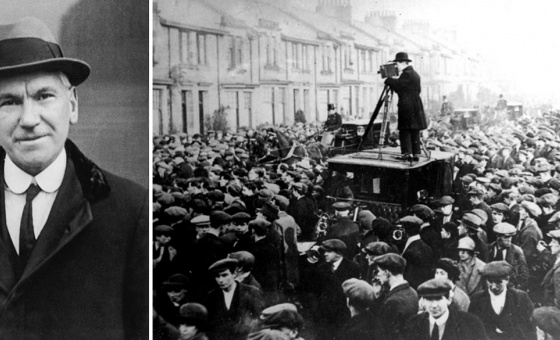This is the last article you can read this month
You can read more article this month
You can read more articles this month
Sorry your limit is up for this month
Reset on:
Please help support the Morning Star by subscribing here
IN MY early twenties, I got a job in a record shop. For a music enthusiast, it seemed like the ideal workplace. On my first day, the deputy manager made me clean the toilets, which hadn’t been cleaned for months.
On the second day, he “accidentally” shoved me into the shelves behind the counter. All the CDs fell on top of me, and he told me off for being clumsy, made me put them back in order.
On the third day, he referred a posh customer to me who was yelling and swearing about Mozart’s The Magic Flute. And so on, for the next few months — until I quit, feeling that I’d never be good at any job, if even working in music didn’t suit me.
In retrospect, it seems obvious this was bullying. I was blaming myself, as many victims do, for what was actually being done to me. While it was happening, though, the loaded word bullying never crossed my mind. Bullying was something that belonged to school days. Bullying was being punched by a big kid behind the bike sheds. Bullying wasn’t a concerted campaign of psychological and (occasionally) physical abuse between adults.
But of course it can be. Indeed, adult bullying is sometimes worse than childhood bullying, because adults use language more cleverly, weaponising positions of power. All too often, power is its own justification: being a deputy manager is justification enough for terrible behaviour.
Power also blinds people to abuse. Victims (aka “targets”) of bullying can remain unaware of what is happening for months, even years. “This is how we rub along,” “Haven’t you got a sense of humour?” “You’re making a mountain out of a molehill” — all these are common expressions used to disguise bullying from victims, and make it seem like it’s their fault they feel alienated.
This is the false consciousness of bullying: that people can live with bullying for long periods without recognising it as such. As Tim Field suggests in his book, Bully in Sight, “Not recognising what is happening” is one of the “main reasons that people put up with bullying for so long.”
A lot of damage can be done by not recognising what is happening. I ended my job at the record shop ill and convinced I was useless at paid work.
Learning to diagnose the symptoms and patterns of bullying early on is vital for victims and organisations alike. There are things I’ve learnt since that I wish could go back and tell my 30-year-ago self.
I can’t do that, but at least, in this National Anti-Bullying Week (November 11-15), I can share some of them here, in the hope they might help other people recognise bullying for what it is:
1. First and foremost: bullying is always about power. As Swedish psychologist Dan Olweus defines it, bullying is usually “directed against a person who has difficulty defending himself or herself … in an interpersonal relationship characterised by an … imbalance of power or strength.”
2. Because power is complicated in our society, so is bullying: a deputy manager might be bullying a sales assistant because the former is themselves being bullied by their manager, and so on.
3. Hence, bullying is often a cycle: someone who is bullied in one context (for example, at home) will go on to bully someone else in another (for example, in school). Bullying is imitative, self-replicating, viral.
4. It is also repetitive, often defined as abusive behaviour that is repeated over time.
5. Because of all this, bullies can feel that they are the victims. Sometimes, this is true, sometimes just a pretext.
6. The causes of bullying can also be genuine or pretext. Undoubtedly, bullying often happens due to some perceived difference between bully and victim (regarding ethnicity, sexuality, gender, disability, etc). But occasionally, what lurks beneath all the excuses is motiveless sadism: the pleasure of exercising power for its own sake.
7. That exercise of power always conceals itself. Bullying almost never admits its own existence: it hides behind regulations or bike sheds or expressions like: “It’s just how we rub along.” One particularly powerful technique that bullies use to hide what they’re doing is “non-linear bullying”: ie mingling strange moments of kindness with abuse. Bullying is rarely monolithically brutal. As victims of domestic abuse understand, it can also weaponise care, even affection.
8. Not unlike affection, bullying singles people out. Bullying isolates victims, while bullies often band together, along with sidekicks and bystanders. Bullying is collective; victimhood is individualistic, lonely.
9. That is why victims should always try and crowd the relationship with others, sharing their experience with parents, teachers, colleagues, and, where necessary, external organisations (see below). There are no simple answers to bullying, but not speaking out is the opposite of an answer.
10. Meanwhile, it’s important to try not to let bullying destroy what one really loves. The Magic Flute is still my favourite opera.
Organisations that provide information and support include the Anti-Bullying Alliance (anti-bullyingalliance.org.uk), The National Bullying Helpline (www.nationalbullyinghelpline.co.uk), and, for school bullying, Kidscape (www.kidscape.org.uk). Thanks to all of them for their assistance with this article.
Jonathan Taylor is the author of the memoir A Physical Education: On Bullying, Discipline & Other Lessons (Goldsmiths, 2024).










